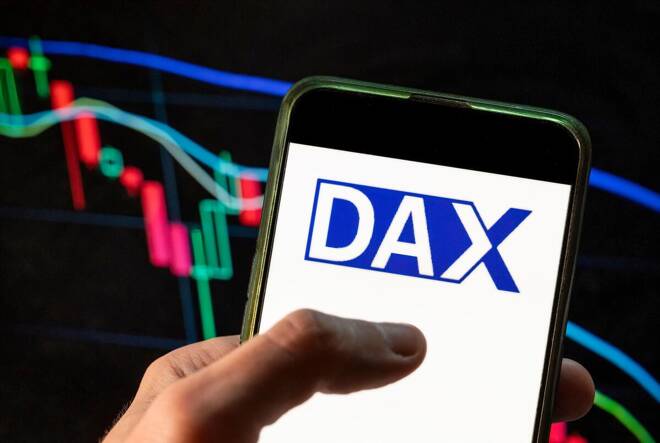Advertisement
Advertisement
DAX Index: German Business Sentiment and Outlook: What to Expect Next
By:
German business sentiment will be in focus before inflation and consumer confidence numbers this week. ECB commentary also needs consideration.
Highlights
- The DAX ended the Friday session down 0.79 points at 16,751.
- Economic indicators and policy support from China delivered early gains while weaker-than-expected euro area data weighed on the DAX.
- On Monday, German business sentiment and the ECB will draw investor interest.
Overview of the DAX Performance on Friday
The DAX ended the Friday session down 0.79 points. Following a 0.08% loss on Thursday, the DAX ended the Friday session at 16,751.
China Economic Data and PBoC Stimulus Deliver Early Gains
On Friday, upbeat economic indicators from China and PBoC policy measures drove demand for riskier assets. A pickup in industrial production and retail sales signaled a possible momentum shift in the Chinese economy. Industrial production increased by 6.6% year-over-year in November vs. 4.6% in October. Retail sales were up 10.1% year-over-year vs. 7.6% in October.
Preliminary Private Sector PMIs Raise Recession Threat
On Friday, preliminary private sector PMIs for December signaled a reverse course. Weaker German service sector activity pulled the German Composite PMI down from 47.8 to 46.7. Notably, the Eurozone Composite PMI slipped from 47.6 to 47.0, with the Services PMI declining from 48.7 to 48.1. The Eurozone Manufacturing PMI remained unchanged at 42.0.
In December, the Eurozone Manufacturing Output Index and Services PMI Business Activity Index fell to 2-month lows. The weak macroeconomic backdrop and ECB forward guidance from Thursday raised the threat of a euro area recession.
US Economic Indicators Support Bets on a Soft Landing
US service sector activity picked up in December, raising bets on a soft landing. The better-than-expected services data supported a DAX recovery from session lows.
On Friday, the Dow and the Nasdaq Composite Index saw gains of 0.15% and 0.35%, while the S&P 500 slipped by 0.01%.
The Friday Market Movers
Auto stocks were among the best performers for the second session. Economic indicators and stimulus measures from China contributed to the gains. Mercedes Benz Group and Daimler Truck Holding ended the session up 1.37% and 1.24%, respectively. BMW and Volkswagen saw gains of 0.51% and 0.19%. However, Porsche bucked the trend, falling 0.25%.
However, Symrise AG and Adidas were a drag on Friday. Symrise AG tumbled by 7.62%. Profit-taking, concerns about inflation, and the outlook for consumer spending likely contributed to the loss. PUMA shares slid by 4.00%, dragging Adidas into negative territory. Adidas and Puma suffered from concerns about possible consumer spending trends.
German Business Sentiment in the Spotlight
On Monday, the German economy will be in focus. The German Ifo Business Climate Index figures for December will garner investor interest. A pickup in sentiment toward current conditions and outlook could support the buyer appetite for DAX-listed stocks.
While the headline figure will move the dial, investors must consider the expectations index and sector-specific trends. Economists forecast the German Ifo Business Climate Index to increase from 87.3 to 87.8 in December.
Beyond the economic indicators, investors must consider ECB commentary. ECB Chief Economist Philip Lane and Executive Board member Isabel Schnabel are on the calendar to speak on Monday. Views on the economy, inflation, and the ECB rate path will move the dial. Hawkish chatter could pressure the DAX at current levels.
US Housing Sector: Economic Litmus Test
On Monday, the US housing sector will be in the spotlight. The NAHB Housing Market Index will provide a snapshot of the US housing market at the end of the year. Upbeat numbers could signal a pickup in housing sector activity over the next few months. However, sub-50 remains a negative signal. Elevated interest and mortgage rates affect demand.
Economists forecast the NAHB Housing Market Index to increase from 34 to 36 in December.
The futures markets pointed to a mixed start to the Monday session. The DAX was down 39 points, while the Nasdaq mini was up 17 points.
Short-Term Forecast
Near-term DAX trends will likely hinge on business/consumer confidence and inflation numbers. Sticky inflation and uptrends in consumer confidence across the euro area would support the higher-for-longer ECB rate path. An upswing in US consumer confidence, personal income/spending, and the Core PCE Price Index could reduce bets on a Q1 2024 Fed rate cut.
More hawkish central bank rate path projections would impact the appetite for riskier assets.
DAX Technical Indicators
Daily Chart
The DAX remained above the 50-day and 200-day EMAs, with the EMAs affirming bullish price signals.
A DAX move through the 16,850 handle would give the bulls a run at the Thursday ATH 17,003.
The ECB, German business sentiment and the US housing market are focal points on Monday.
However, a break below the 16,700 handle would bring the 16,470 support level into play.
The 14-day RSI reading of 80.71 shows the DAX in overbought territory. Selling pressure may intensify at the Thursday ATH of 17,003.
4-Hourly Chart
The DAX sat above the 50-day and 200-day EMAs, with the EMAs reaffirming bullish price signals.
A DAX break above the 16,850 handle would support a move to the Thursday ATH 17,003.
However, a fall below the 16,700 handle would give the bears a run at the 16,470 support level. Buying pressure could intensify at the 16,470 support level. The 50-day EMA is confluent with the support level.
The 58.50 14-4 hour RSI suggests a DAX return to the Thursday ATH of 17,003 before entering overbought territory.
For a look at the economic events, check out our economic calendar.
About the Author
Bob Masonauthor
With over 28 years of experience in the financial industry, Bob has worked with various global rating agencies and multinational banks. Currently he is covering currencies, commodities, alternative asset classes and global equities, focusing mostly on European and Asian markets.
Advertisement
